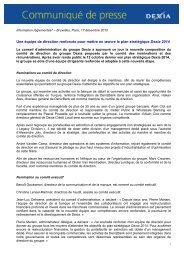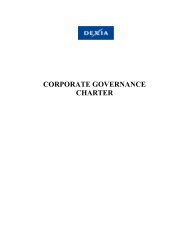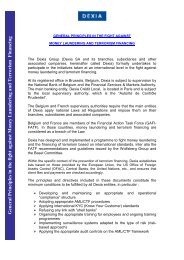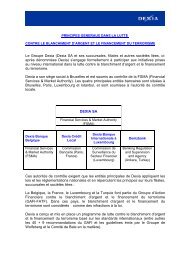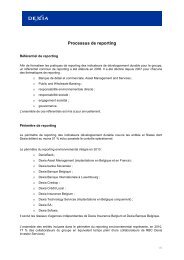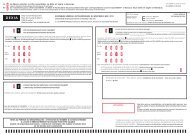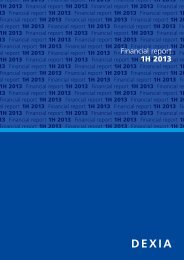Annual report 2009 - Dexia.com
Annual report 2009 - Dexia.com
Annual report 2009 - Dexia.com
- No tags were found...
Create successful ePaper yourself
Turn your PDF publications into a flip-book with our unique Google optimized e-Paper software.
Notes to the consolidated fi nancial statementsway of penalty is recognised as an expense in the period inwhich termination takes place.If the lease agreement substantially transfers the risk andrewards of ownership of the asset, the lease is recorded as afinance lease and the related asset is capitalised. At inceptionthe asset is recorded at the lower of the present value ofthe minimum lease payments or fair value and is depreciatedover its estimated useful life. The corresponding rental obligationsare recorded as borrowings and interest paymentsare recorded using the effective interest-rate method.1.25.2. A <strong>Dexia</strong> <strong>com</strong>pany is the lessorWhen assets held are subject to a finance lease, <strong>Dexia</strong>recognises the net investment in the lease as a receivable.Lease in<strong>com</strong>e is recognised over the term of the lease usingthe net investment method (before tax), which reflects a constantperiodic rate of return.1.26. Sale and repurchase agreementsand lending of securitiesSecurities sold subject to a linked repurchase agreement(“repos”) remain in the financial statements recognised asfinancial assets held for trading, financial assets available forsale or financial assets held to maturity. The correspondingliability is included in “Due to banks” or “Customer borrowingsand deposits” as appropriate. The asset is <strong>report</strong>ed aspledged in the notes.Securities purchased under agreements to resell (“reverserepos”) are recorded as:• an obligation to return securities within off-balance-sheetitems; and• “Due to banks” or “Customer borrowings and deposits”as appropriate.The difference between the sale and repurchase price istreated as interest in<strong>com</strong>e or expense and is accrued overthe life of the agreements using the effective interest-ratemethod.Securities lent to counterparties are retained in the financialstatements.Securities borrowed are not recognised in the financialstatements.If they are sold to third parties, the gain or loss is included in“Net in<strong>com</strong>e from financial instruments at fair value throughprofit or loss” and the obligation to return them is recordedat fair value in “Financial liabilities measured at fair valuethrough profit or loss”.1.27. BorrowingsBorrowings are recognised initially at fair value, being theirissue proceeds net of transaction costs incurred. Subsequentlyborrowings are stated at amortised cost and any differencebetween net proceeds and the redemption value isrecognised in the statement of in<strong>com</strong>e over the period of theborrowings using the effective interest-rate method.Debts are included in the financial statements, based on thesubstance of their underlying contracts more than their legalform.1.28. Deferred in<strong>com</strong>e taxDeferred in<strong>com</strong>e tax is provided in full, using the liabilitymethod, on temporary differences arising between the taxbases of assets and liabilities and their carrying amounts inthe financial statements.The principal temporary differences arise from depreciation ofproperty, plant and equipment, revaluation of certain financialassets and liabilities including derivative contracts, provisionsfor pensions and other post retirement benefits, provisions forloan and other impairments and tax losses carried forward;and, in relation to acquisitions, from the difference betweenthe fair values of the net assets acquired and their tax base.The rates enacted or substantively enacted at the balancesheetdate are used to determine deferred in<strong>com</strong>e tax.Deferred tax assets are recognised to the extent that it isprobable that future taxable profit will be available againstwhich the temporary differences can be utilised.Deferred in<strong>com</strong>e tax is provided on temporary differencesarising from investments in subsidiaries, associates and jointventures, except where the timing of the reversal of the temporarydifference can be controlled and it is probable that thedifference will not reverse in the foreseeable future.Deferred tax related to fair value remeasurement of available-for-saleinvestments and cash flow hedges, which arecharged or credited directly to equity, is also credited orcharged directly to equity.1.29. Employee benefitsEmployee benefit obligations are measured at the present valueof the estimated future cash outflows using interest rates of corporatebonds rated AA, which have terms to maturity approximatingto the terms of the related liability and taking intoconsideration also actuarial and demographic assumptions.Qualified internal and external actuaries carry out valuationsof these obligations. All valuations assumptions and resultsare reviewed and validated by an external actuary for <strong>Dexia</strong>that ensures that all calculations are harmonised and calculatedin conformity with IAS 19.1.29.1. Pension obligations<strong>Dexia</strong> operates a number of defined benefit and definedcontribution plans throughout the world, the assets of whichare generally held in insurance <strong>com</strong>panies or pension funds.The pension plans are generally funded by payments fromemployees and by the relevant <strong>Dexia</strong> <strong>com</strong>panies.1.29.1.1. Defined benefit plansFor defined benefit plans, pension costs are assessed usingthe Projected Unit Credit Method.Under this method, the cost of providing pensions is chargedto the statement of in<strong>com</strong>e so as to spread the regular costover the service lives of employees. Net cumulative unrecognisedactuarial gains and losses exceeding the corridor(greater than 10% of the present value of the gross definedbenefit obligation and 10% of the fair value of any planassets) are recognised in in<strong>com</strong>e over the average remainingworking lives of the plan participants.The cost of plan amendments are recognised in in<strong>com</strong>e overthe average period until the benefits be<strong>com</strong>e vested.Management <strong>report</strong>Consolidatedfinancial statements<strong>Annual</strong> financial statementsAdditional information<strong>Annual</strong> <strong>report</strong> <strong>2009</strong> <strong>Dexia</strong> 117



